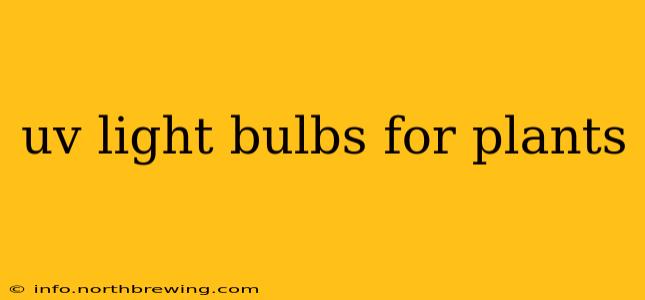Ultraviolet (UV) light plays a crucial, often overlooked, role in plant growth and health. While plants primarily utilize visible light for photosynthesis, UV-B radiation, a specific type of UV light, triggers a range of physiological responses that can significantly enhance their resilience and overall development. This comprehensive guide explores the benefits, types, and effective application of UV light bulbs for plants.
What are the Benefits of Using UV Light Bulbs for Plants?
UV-B radiation, a component of sunlight, isn't just about sunburn; it's a powerful environmental signal for plants. Exposure to UV-B light triggers several key benefits:
-
Enhanced Disease Resistance: UV-B exposure stimulates the production of secondary metabolites, acting as natural pesticides and fungicides, making plants more resistant to diseases and pests. This results in healthier plants that require less intervention.
-
Increased Production of Flavonoids and Other Beneficial Compounds: Flavonoids are potent antioxidants contributing to a plant's vibrant colors and robust health. UV-B light significantly boosts their production, improving the nutritional value and overall quality of your plants, particularly fruits and vegetables.
-
Improved Structural Integrity: UV-B radiation strengthens plant cell walls, making them more resistant to mechanical stress and environmental damage. This leads to more robust plants less susceptible to damage from wind, rain, or handling.
-
Stimulated Flowering and Fruiting: In certain plant species, carefully controlled UV-B exposure can promote earlier and more abundant flowering and fruiting, resulting in higher yields.
What Types of UV Light Bulbs are Best for Plants?
The market offers various UV light bulbs; understanding their differences is crucial for selecting the right one for your needs:
-
UV-B Fluorescent Bulbs: These bulbs offer a good balance of UV-B output and affordability. They are readily available and relatively easy to incorporate into existing grow setups. However, their lifespan might be shorter compared to other options.
-
UV-B LEDs: LEDs are energy-efficient and offer a longer lifespan. They are also available in different wavelengths, allowing for precise control over UV-B exposure. The higher initial cost is often offset by their longevity and energy savings.
-
UV-A and UV-B Combination Bulbs: Some bulbs emit both UV-A and UV-B light. While UV-A is less impactful than UV-B on plant physiology, it can still contribute to overall plant health and development.
How Much UV Light Do Plants Need?
The ideal amount of UV-B exposure varies significantly depending on the plant species, growth stage, and overall environmental conditions. Overexposure can be detrimental, causing damage similar to sunburn. It's crucial to start with low levels of UV-B and gradually increase exposure based on observation. Monitor your plants closely for signs of stress, such as leaf scorching or discoloration. Consult resources specific to your plant type for optimal UV-B exposure guidelines.
How to Safely Use UV Light Bulbs for Plants?
Safety is paramount when working with UV light. UV-B radiation can harm human eyes and skin. Always wear appropriate protective eyewear and clothing when handling UV bulbs or working near them. Ensure the bulbs are properly installed and shielded to prevent accidental exposure.
Can I Use UV Light Bulbs with My Existing Grow Lights?
Yes, in many cases, you can supplement your existing grow lights with UV-B bulbs. However, carefully consider the placement and intensity. It's best to introduce UV-B gradually to allow plants to adapt.
What are the potential drawbacks of using UV light bulbs for plants?
While beneficial, excessive UV-B radiation can harm plants, causing leaf burn and stunted growth. Careful monitoring and gradual introduction of UV-B light are crucial to avoid negative consequences. Also, the initial investment in specialized UV bulbs can be higher than for standard grow lights.
Do all plants benefit equally from UV light?
No, the response to UV-B radiation varies across different plant species. Some plants show greater benefits than others. Researching the specific requirements of your plant is crucial for optimal results.
Conclusion:
Supplementing your grow light setup with UV light bulbs can significantly benefit plant growth, health, and yield, but understanding the principles of appropriate application and safety is crucial. Remember to research the specific needs of your plants and proceed gradually to avoid harmful overexposure. By carefully managing UV-B exposure, you can unlock the full potential of your plants and achieve healthier, more vibrant growth.
